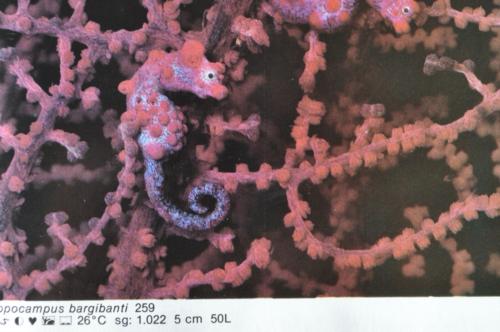
By
Bob HalsteadIf you have only been diving for a few years you might find this hard to believe. But it is true – Sport Diving existed before Pygmy Seahorses became every diver’s favourite critter!
Every diver except me, that is.
Some of us dived through the 1960’s, 70’s and, yes, 80’s without ever having to think about Pygmy Seahorses, let alone find one.
My introduction was via a photograph by Allan Power, famous for his President Coolidge dive operation on Santo in Vanuatu. It was published in Dr. Burgess’s Atlas of Marine Aquarium Fishes. I understand Allan had found a pair of the seahorses after collecting a sea fan from the depths to put in an aquarium.
He went back in the water with the seahorses and took the great photo I saw in the book. The information provided with the photograph included the facts that the scientific name was Hippocampus bargibanti, the water temperature was around 26 deg C. and the size of the seahorse was 5 cm., yes, FIVE cm.
I guessed the seahorses would also be in Papua New Guinea, and wasted years on and off trying to find 5 cm seahorses on the particular sea fan species shown in the photograph. So let me tell you right away these pygmy seahorses are really small, probably nearer 0.5 cm than 5 cm!
One day I found a suitable “Muricela” sea fan and decided I was not going to leave until I had found something, anything, on it. An allied cowry, or an interesting crab or anything! Imagine my surprise when I actually found a really tiny seahorse. It was not the same as the one in Allan’s photo, mine had white specks on it, but then I thought perhaps this is the juvenile! So I took some pictures and eventually had one published in The Coral Reefs Of Papua New Guinea, a book we produced for the European Union to celebrate the year of the Coral Reef, 1996.
It must have been around 1998 when Pygmy Seahorse mania first infected the diving community. This mania is getting steadily worse. They were discovered in PNG first from Walindi Dive Resort in New Britain, then from Loloata Dive Resort in Port Moresby. Then Everywhere.
It basically ruined diving. “You have to see our Pygmy Seahorses” was the greeting every time I turned up somewhere for a dive. Just to be polite I would have to trail behind the dive guide and join 8 others struggling to see this pathetic microscopic beast. Then the rough stuff started as divers elbowed in close enough to get a photo. Of course you needed a 500 mm lens with +15 dioptres or equivalent to shoot a full frame picture of it (well, 105 mm and +2 dioptres anyway). That is if you could still see it after the guide stopped pointing, and it had not turned away from you, as they almost invariably do.
On a dive expedition to the Solomon Islands I was shown a skinny relative of H. bargibanti, now named H. denise, and decided on a different approach. I shot the fish with a 55 mm lens in such a way that it looked like a really tiny sea horse on a big sea fan. This photo I submitted as a full-page picture in my book Coral Sea Reef Guide. Whoever did the art work evidently did not like my picture as they proceeded to digitally clone the one sea horse, and make it into three (you can spot the two fakes as they cast no shadow on the sea fan). Since it costs a fortune to replace a colour page in a book, they are still there, page 49.
Of course by this time I realised that my original Pygmy Seahorse was not a juvenile at all, but a completely new species. To get it named I would need to collect at least a couple of adult specimens. Alas, I do not seem capable of finding any more. Due to my advancing age I would need to dive with a huge magnifying glass. Now other, young-eyed, divers are starting to find MY seahorse in Fiji and Walindi and Indonesia.
I can tell you diving was better when we just went looking for sharks. But have I told you about the time I found an adult deepwater pygmy shark only 12 cm long? – you should have seen it!
PS Inevitably, another diver, Mike Severns, did find and collect the white spotted Pygmy Sea Horse. It has been named, in 2008, Hippocampus severnsi. Well done Mike!
http://www.halsteaddiving.com/adult-section-stories/deep-tho...ther-pygmy-seahorse/